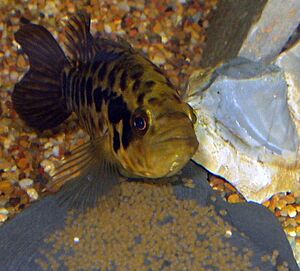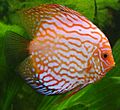Cichlid facts for kids
Quick facts for kids Cichlids |
|
|---|---|
 |
|
| Common freshwater angelfish, Pterophyllum scalare |
|
| Scientific classification | |
| Kingdom: | |
| Phylum: | |
| Class: | |
| Order: | |
| Family: |
Cichlidae
|
Cichlids are a large family of fish called Cichlidae. They belong to the group of fish known as Perciformes. This family is huge and very diverse! Scientists have officially described at least 1,650 different species of cichlids. This makes them one of the biggest families of vertebrates (animals with backbones).
New cichlid species are found every year, and many more are still waiting to be discovered. Experts think there might be between 2,000 and 3,000 species in total. Cichlids are also very popular freshwater fish that many people keep in their home aquariums.
Contents
About Cichlids
Cichlids come in many different sizes. Some are as small as 2.5 cm (about 1 inch) long, while others can grow to almost 1 meter (about 3 feet) long! They also have many different body shapes. However, most cichlids are medium-sized, oval-shaped, and a bit flat on their sides.
Many cichlids are important as food fish, meaning people eat them. Others are popular for sport fishing. This family also includes many well-known aquarium fish, like the beautiful angelfish.
Sadly, cichlids have the most endangered species among all vertebrate families. Their amazing variety in the African Great Lakes is very important for studying how new species develop over time. Some cichlids have been moved to waters outside their natural homes and have caused problems there.
How Cichlids Eat
Many cichlids are mostly herbivores, which means they eat algae and plants. Smaller animals, especially invertebrates (animals without backbones), are usually only a small part of their diet. Cichlids have special teeth in their throats, called pharyngeal teeth. These teeth help them crush food while their jaws hold it. This allows cichlids to eat many different kinds of food and live in various places.
Cichlid Reproduction
Cichlids have very organized ways of breeding and raising their young.
Parental Care
All cichlid species take care of their eggs and young fish. They often look after their free-swimming babies for weeks or even months! For example, the species Neolamprologus pulcher has a special system where one breeding pair gets help from many other cichlids that are not the main parents.
Cichlid Conservation
In 2010, the International Union for the Conservation of Nature (IUCN) looked at cichlid populations. They found that 184 species were considered vulnerable, 52 were endangered, and 106 were critically endangered. This means many cichlids need our help to survive.
Cichlids for Sport Fishing
Many large cichlids are popular for sport fishing. The peacock bass (Cichla species) from South America is one of the most popular sportfish. It has been introduced to many waters around the world. In Florida, this fish brings in millions of dollars each year from fishing activities.
Cichlids in Aquariums
Since 1945, cichlids have become more and more popular as aquarium fish. The most common species kept by hobbyists is Pterophyllum scalare, which comes from the Amazon River in South America. This fish is known as the "angelfish". Another popular cichlid that is easy to find is the oscar.
Images for kids
-
The bumblebee cichlid, Pseudotropheus crabro, is specialised in feeding on parasites from the catfish Bagrus meridionalis.
-
A female Cyphotilapia frontosa mouthbrooding fry, which can be seen looking out her mouth
-
The "red Texas" cichlid is not a Texas cichlid (Herichthys cyanoguttatus) but an intergeneric hybrid of Herichthys and Amphilophus parents.
-
A leucistic long-finned form of the oscar, A. ocellatus
-
The oscar (Astronotus ocellatus) is one of the most popular cichlids in the fishkeeping hobby.
-
The butterfly peacock bass (Cichla ocellaris) was introduced intentionally in Florida as gamefish.
-
Sexual dimorphism is common in cichlids. Shown here are a male (front, with egg spots) and a female (rear) Maylandia lombardoi.
-
A pair of blue rams (Mikrogeophagus ramirezi), male in front, female behind. Many cichlids form strong pair bonds while breeding.
-
Lake Malawi, Eastern Africa, is home to numerous cichild species including this Livingston's cichlid (Nimbochromis livingstonii).
-
A shell-brooding cichlid of the genus Lamprologus from Lake Tanganyika in East Africa
-
The Texas cichlid (Herichthys cyanoguttatus) is the only cichlid native to the United States.
-
Pelvicachromis pulcher is a West African riverine cichlid, and part of the aquarists dwarf cichlid group.
-
Ivanacara adoketa, a dwarf cichlid from Brazil
See also
 In Spanish: Cíclidos para niños
In Spanish: Cíclidos para niños





























